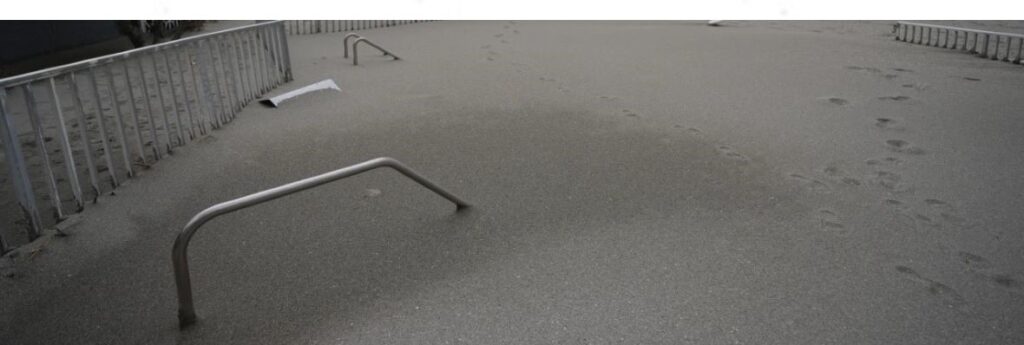When a hurricane sets its sights on Florida, storm-weary residents may think of catastrophic wind, hammering rain and dangerous storm surge. Mounds of sand swallowing their homes? Not so much. Yet, that’s the reality for some after Hurricanes Helene and Milton clobbered Florida’s Gulf Coast with back-to-back hits in less than two weeks.
Storm surge as high as 3 metres swept mountains of sand into communities — in some areas, 1.5 metres tall or higher.
The fine, white sand helps make Florida’s beaches among the best in the world. But the powerful storms have turned the precious commodity into a costly nuisance, with sand creating literal barriers to recovery as homeowners and municipalities dig their way out.
“I’ve never seen sand like this,” said Scott Bennett, a contractor who has worked in storm recovery since 2005’s Hurricane Katrina. “Wind, rain, water, but never sand.”
The morning after Hurricane Milton crashed ashore, the roads of Bradenton Beach, about an hour’s drive south of Tampa, were lined with sandbanks less than a metre high, surrounding some bungalows. The views of the Old Florida beach town were not unlike those after a blustery Midwestern blizzard.
“The best way to describe it, it’s like getting four to six feet (1.2 to 1.8 meters) of snow up north,” said Jeremi Roberts, a member of the State Emergency Response Team surveying the damage that day.
Another hour south, Ron and Jean Dyer said the storms blew about 0.9 metres of sand up against their condo building on Venice Island. “The beach just moved over everything,” Ron Dyer said.
It had taken dozens of volunteers armed with shovels and wheelbarrows two days to dig all the sand out of the condo’s pool after Hurricane Helene, only to see Milton fill it back in, he said.
“They just kept digging and wheeling and digging and wheeling. … They were there for two days doing that,” he said. “We got to do it all over again.”
Storm recovery contractor Larry West estimates that his team will do about $300,000 worth of work just to clean up all the sand and debris left behind at one of the condo buildings he’s restoring in Manasota Key, about 56 km. south of Sarasota. He expects many property owners, especially those who don’t have flood insurance, will have to pay out of pocket for this kind of cleanup.
“The poor homeowner who’s going to have to spend $150,000 cleaning up, that’s going to hurt them hard,” West said.
West said he is not sure where to take the sand, after he heard that a local park that Charlotte County officials designated as a drop-off site was filling up with the stuff. According to the county, two sites remain open for dropping off sand.
“Right now, I’m building mountains in their parking area,” West said of the condo complex he’s restoring. “We’re just kind of waiting to find out if they’re gonna have us transport it to a different location.”
Officials in hard-hit Pinellas County, home to St. Petersburg, are still crunching the numbers on just how big of a bite Helene and Milton took out of the coastline there, but county Public Works director Kelli Hammer Levy puts the current estimate at 1 million cubic yards (765,000 cubic metres) of sand lost.
“A lot of volume has been lost, and that’s our main concern here right now,” she told the county’s Tourism Development Council. “It’s hard to kind of stay positive with some of this stuff. I know the pictures are not what we want to see.”
For perspective, a 2018 beach renourishment project to shore up the county’s coastline with 1.3 million cubic yards (994,000 cubic metres) of sand cost more than $50 million, according to the U.S. Army Corps of Engineers.
Levy is hopeful that much of the displaced sand can be repurposed. Pinellas officials are encouraging residents to cart their sand right back out onto the beach – as long as it’s clean.
The county has also opened a drop-off location where residents can leave sand for workers to screen and clean, or dispose of if it’s contaminated, under guidance from the state’s Department of Environmental Protection.
In the meantime, Florida residents are continuing to dig out of the storm-driven sand, many of them by hand.
“Every shovelful is heavy,” said West, the construction contractor. “This is horrendous, as far as the cleanup.”
If you enjoyed or found this story useful, we’d appreciate if you would forward it to a colleague or friend who may also enjoy it. If, on the other hand, a friend shared it with you, welcome! You can get all the latest travel news and reviews from Travel Industry by simply clicking HERE.

